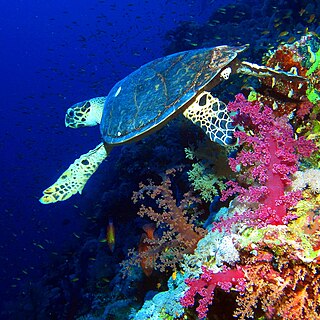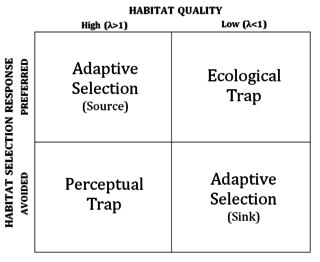Related Research Articles

Ecology is the natural science of the relationships among living organisms, including humans, and their physical environment. Ecology considers organisms at the individual, population, community, ecosystem, and biosphere level. Ecology overlaps with the closely related sciences of biogeography, evolutionary biology, genetics, ethology, and natural history.

Sea turtles, sometimes called marine turtles, are reptiles of the order Testudines and of the suborder Cryptodira. The seven existing species of sea turtles are the flatback, green, hawksbill, leatherback, loggerhead, Kemp's ridley, and olive ridley. Six of the seven sea turtle species, all but the flatback, are present in U.S. waters, and are listed as endangered and/or threatened under the Endangered Species Act. All but the flatback turtle are listed as threatened with extinction globally on the IUCN Red List of Threatened Species. The flatback turtle is found only in the waters of Australia, Papua New Guinea, and Indonesia.
This glossary of ecology is a list of definitions of terms and concepts in ecology and related fields. For more specific definitions from other glossaries related to ecology, see Glossary of biology, Glossary of evolutionary biology, and Glossary of environmental science.
In biology, adaptation has three related meanings. Firstly, it is the dynamic evolutionary process of natural selection that fits organisms to their environment, enhancing their evolutionary fitness. Secondly, it is a state reached by the population during that process. Thirdly, it is a phenotypic trait or adaptive trait, with a functional role in each individual organism, that is maintained and has evolved through natural selection.

In biology, two related species or populations are considered sympatric when they exist in the same geographic area and thus frequently encounter one another. An initially interbreeding population that splits into two or more distinct species sharing a common range exemplifies sympatric speciation. Such speciation may be a product of reproductive isolation – which prevents hybrid offspring from being viable or able to reproduce, thereby reducing gene flow – that results in genetic divergence. Sympatric speciation may, but need not, arise through secondary contact, which refers to speciation or divergence in allopatry followed by range expansions leading to an area of sympatry. Sympatric species or taxa in secondary contact may or may not interbreed.

The loggerhead sea turtle is a species of oceanic turtle distributed throughout the world. It is a marine reptile, belonging to the family Cheloniidae. The average loggerhead measures around 90 cm (35 in) in carapace length when fully grown. The adult loggerhead sea turtle weighs approximately 135 kg (298 lb), with the largest specimens weighing in at more than 450 kg (1,000 lb). The skin ranges from yellow to brown in color, and the shell is typically reddish brown. No external differences in sex are seen until the turtle becomes an adult, the most obvious difference being the adult males have thicker tails and shorter plastrons than the females.

In ecology, r/K selection theory relates to the selection of combinations of traits in an organism that trade off between quantity and quality of offspring. The focus on either an increased quantity of offspring at the expense of individual parental investment of r-strategists, or on a reduced quantity of offspring with a corresponding increased parental investment of K-strategists, varies widely, seemingly to promote success in particular environments. The concepts of quantity or quality offspring are sometimes referred to as "cheap" or "expensive", a comment on the expendable nature of the offspring and parental commitment made. The stability of the environment can predict if many expendable offspring are made or if fewer offspring of higher quality would lead to higher reproductive success. An unstable environment would encourage the parent to make many offspring, because the likelihood of all of them surviving to adulthood is slim. In contrast, more stable environments allow parents to confidently invest in one offspring because they are more likely to survive to adulthood.
A functional group is merely a set of species, or collection of organisms, that share alike characteristics within a community. Ideally, the lifeforms would perform equivalent tasks based on domain forces, rather than a common ancestor or evolutionary relationship. This could potentially lead to analogous structures that overrule the possibility of homology. More specifically, these beings produce resembling effects to external factors of an inhabiting system. Due to the fact that a majority of these creatures share an ecological niche, it is practical to assume they require similar structures in order to achieve the greatest amount of fitness. This refers to such as the ability to successfully reproduce to create offspring, and furthermore sustain life by avoiding alike predators and sharing meals.

A spongivore is an animal anatomically and physiologically adapted to eating animals of the phylum Porifera, commonly called sea sponges, for the main component of its diet. As a result of their diet, spongivore animals like the hawksbill turtle have developed sharp, narrow bird-like beak that allows them to reach within crevices on the reef to obtain sponges.
Sensory ecology is a relatively new field focusing on the information organisms obtain about their environment. It includes questions of what information is obtained, how it is obtained, and why the information is useful to the organism.

Evolutionary mismatch is the evolutionary biology concept that a previously advantageous trait may become maladaptive due to change in the environment, especially when change is rapid. It is said this can take place in humans as well as other animals.
Source–sink dynamics is a theoretical model used by ecologists to describe how variation in habitat quality may affect the population growth or decline of organisms.

The medium ground finch is a species of bird in the family Thraupidae. It is endemic to the Galapagos Islands. Its primary natural habitat is tropical shrubland. One of Darwin's finches, the species was the first which scientists have observed evolving in real-time.
Ecological traps are scenarios in which rapid environmental change leads organisms to prefer to settle in poor-quality habitats. The concept stems from the idea that organisms that are actively selecting habitat must rely on environmental cues to help them identify high-quality habitat. If either the habitat quality or the cue changes so that one does not reliably indicate the other, organisms may be lured into poor-quality habitat.
In ecology, a priority effect refers to the impact that a particular species can have on community development as a result of its prior arrival at a site. There are two basic types of priority effects: inhibitory and facilitative. An inhibitory priority effect occurs when a species that arrives first at a site negatively affects a species that arrives later by reducing the availability of space or resources. In contrast, a facilitative priority effect occurs when a species that arrives first at a site alters abiotic or biotic conditions in ways that positively affect a species that arrives later. Inhibitory priority effects have been documented more frequently than facilitative priority effects. Studies indicate that both abiotic and biotic factors can affect the strength of priority effects. Priority effects are a central and pervasive element of ecological community development that have significant implications for natural systems and ecological restoration efforts.
Ecological inheritance occurs when organisms inhabit a modified environment that a previous generation created; it was first described in Odling-Smee (1988) and Odling-Smee et al. (1996) as a consequence of niche construction. Standard evolutionary theory focuses on the influence that natural selection and genetic inheritance has on biological evolution, when individuals that survive and reproduce also transmit genes to their offspring. If offspring do not live in a modified environment created by their parents, then niche construction activities of parents do not affect the selective pressures of their offspring. However, when niche construction affects multiple generations, ecological inheritance acts a inheritance system different than genetic inheritance.

A perceptual trap is an ecological scenario in which environmental change, typically anthropogenic, leads an organism to avoid an otherwise high-quality habitat. The concept is related to that of an ecological trap, in which environmental change causes preference towards a low-quality habitat.

Sea turtle migration is the long-distance movements of sea turtles notably the long-distance movement of adults to their breeding beaches, but also the offshore migration of hatchings. Sea turtle hatchings emerge from underground nests and crawl across the beach towards the sea. They then maintain an offshore heading until they reach the open sea. The feeding and nesting sites of adult sea turtles are often distantly separated meaning some must migrate hundreds or even thousands of kilometres.

The following outline is provided as an overview of and topical guide to evolution:

Pollinator-mediated selection is an evolutionary process occurring in flowering plants, in which the foraging behavior of pollinators differentially selects for certain floral traits. Flowering plant are a diverse group of plants that produce seeds. Their seeds differ from those of gymnosperms in that they are enclosed within a fruit. These plants display a wide range of diversity when it comes to the phenotypic characteristics of their flowers, which attracts a variety of pollinators that participate in biotic interactions with the plant. Since many plants rely on pollen vectors, their interactions with them influence floral traits and also favor efficiency since many vectors are searching for floral rewards like pollen and nectar. Examples of pollinator-mediated selected traits could be those involving the size, shape, color and odor of flowers, corolla tube length and width, size of inflorescence, floral rewards and amount, nectar guides, and phenology. Since these types of traits are likely to be involved in attracting pollinators, they may very well be the result of selection by the pollinators themselves.
References
- ↑ Schlaepfer, M.A.; Runge, M.C.; Sherman, P.W. (2002). "Ecological and evolutionary traps". Trends in Ecology and Evolution. 17 (10): 478–480. doi:10.1016/S0169-5347(02)02580-6.
- ↑ Dwernychuk, L.W.; Boag, D.A. (1972). "Ducks nesting in association with gulls-an ecological trap?". Canadian Journal of Zoology. 50 (5): 559–563. doi:10.1139/z72-076.
- ↑ Witherington, B.E. (1997). "The problem of photopollution for sea turtles and other nocturnal animals". In Clemons, J.R.; Bucholz, R. (eds.). Behavioral approaches to conservation in the wild. Cambridge, UK: Cambridge University Press. pp. 303–328. ISBN 0-521-58054-4.
- ↑ Orians, G.H.; Wittenberger, J.F. (1991). "Spatial and temporal scales in habitat selection". American Naturalist. 137: S29–S49. doi:10.1086/285138.
- ↑ Robertson, B.A.; Hutto, R.L. (2006). "A framework for understanding ecological traps and an evaluation of existing evidence". Ecology. 87 (5): 1075–1085. doi:10.1890/0012-9658(2006)87[1075:AFFUET]2.0.CO;2. ISSN 0012-9658. PMID 16761584.